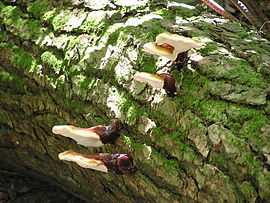Ganoderma tsugae
| Ganoderma tsugae | |
|---|---|
 | |
| Scientific classification | |
| Kingdom: | Fungi |
| Phylum: | Basidiomycota |
| Class: | Agaricomycetes |
| Order: | Polyporales |
| Family: | Ganodermataceae |
| Genus: | Ganoderma |
| Species: | G. tsugae |
| Binomial name | |
| Ganoderma tsugae | |
| Ganoderma tsugae | |
|---|---|
|
| |
| pores on hymenium | |
| cap is flat | |
| hymenium is adnate | |
| stipe is bare | |
| spore print is brown | |
|
ecology is saprotrophic or parasitic | |
| edibility: inedible | |
Ganoderma tsugae, also known as Hemlock varnish shelf, is a flat polypore mushroom of the genus Ganoderma. In contrast to Ganoderma lucidum, to which it is closely related and which it closely resembles, G. tsugae tends to grow on conifers, especially hemlocks.[1] Like G. lucidum, G. tsugae is said to have medicinal properties.[2] Phylogenetic analysis has begun to better differentiate between many closely related species of Ganoderma;[3] however, there is still disagreement as to which have the most medicinal properties. In addition, variations within the same species as well as the growth substrate and environmental conditions all the way through to preparation can have a substantial effect on the medicinal value of the product.
Like G. lucidum, G. tsugae is non-poisonous but generally considered inedible, due to its solid woody nature; however, teas and extracts made from its fruiting bodies allow medicinal use of the compounds it contains. A hot water extraction or tea can be very effective for extracting the polysaccharides; however, an alcohol or alcohol/glycerin extraction method is more effective for the triterpenoids.[4]
References
- ↑ Kuo, M., MushroomExpert.Com, Ganoderma tsugae. (2004, February). Retrieved June 15, 2007.
- ↑ Ching-Hua Su1, et al., Taipei Medical University, Sacchachitin, a Skin Wound Dressing Material from Ganoderma tsugae, 2004. Retrieved June 16, 2007.
- ↑ Soon Gyu Hong, Hack Sung Jung, Phylogenetic analysis of Ganoderma based on nearly complete mitochondrial small-subunit ribosomal DNA sequences, Mycologia July/August 2004 vol. 96 no. 4 742–55.
- ↑ Gary Emberger, Messiah College, Ganoderma tsugae, 2006. Retrieved June 16, 2007.